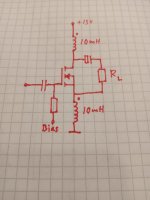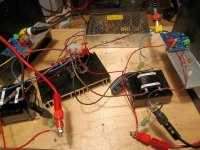Hi,
I was digging through some junk the other day and found a pair of interesting chokes that I bought some time ago and then more or less forgot about. Signal Transformer CL-2-4, a rather small piece of airgapped iron with two 10mH windings that can be wired in parallel for 10mH 4A or in series for 40mH 2A.
40mH 2A sounded close enough to the specs of the Triad choke used in the Zenductor amp and those dual windings struck me as interesting.
Over at the tube forum, we would call this a "Parafeed output stage with 50% cathode feedback" or perhaps "a single ended version of the Macintosh Unity Gain output stage" or maybe even "What the hell is that, and why doesn't it glow?":

Fortunately, I had a pair of old 2SK133 mosfets with bias circuits and everything already attached to heatsinks after my attempts to duplicate Hiragas Nemesis amp a couple of years ago so wiring up a prototype was easy:

No measurements yet but I've been listening for an hour and it sounds surprisingly good, running at 12V 900mA, which should be good for around 3 watts into 8 ohms.
The point here was to build something that is essentially a simple follower but with ~6dBs of gain. The experiment is successful so far, we'll see what the oscilloscope says...
I was digging through some junk the other day and found a pair of interesting chokes that I bought some time ago and then more or less forgot about. Signal Transformer CL-2-4, a rather small piece of airgapped iron with two 10mH windings that can be wired in parallel for 10mH 4A or in series for 40mH 2A.
40mH 2A sounded close enough to the specs of the Triad choke used in the Zenductor amp and those dual windings struck me as interesting.
Over at the tube forum, we would call this a "Parafeed output stage with 50% cathode feedback" or perhaps "a single ended version of the Macintosh Unity Gain output stage" or maybe even "What the hell is that, and why doesn't it glow?":

Fortunately, I had a pair of old 2SK133 mosfets with bias circuits and everything already attached to heatsinks after my attempts to duplicate Hiragas Nemesis amp a couple of years ago so wiring up a prototype was easy:

No measurements yet but I've been listening for an hour and it sounds surprisingly good, running at 12V 900mA, which should be good for around 3 watts into 8 ohms.
The point here was to build something that is essentially a simple follower but with ~6dBs of gain. The experiment is successful so far, we'll see what the oscilloscope says...
Wouldn't that make the whole thing go silent? A dual winding choke is the same thing as a transformer, short one winding in a transformer and the others go down with it?what your ears are sayin' if you block lower winding with big elco?
I guess I could, thought I don't fully understand the point. By "block", I assume you mean bypassing it?
If so, wouldn't it be better to put both windings between + and drain and just insert a small resistor between source and GND?
That would make a transconductance amplifier I believe, very high Zout.
If so, wouldn't it be better to put both windings between + and drain and just insert a small resistor between source and GND?
That would make a transconductance amplifier I believe, very high Zout.
if you want to take care of DC magnetization (nulling), swap polarity of lower winding, and bypass it with whatever largish cap you have at hand
it's easy enough to try, no need for head-banging
take speaker neg from GND, or from B+ or from source .......
it's easy enough to try, no need for head-banging
take speaker neg from GND, or from B+ or from source .......
Ah.
The choke has an airgap that handles the DC magnetization, up to 2A DC according to the data sheet.
The point of putting one winding between source and ground is to get a fair amount of local feedback, so much that the amp can be seen as something between a follower and a gain stage.
The choke has an airgap that handles the DC magnetization, up to 2A DC according to the data sheet.
The point of putting one winding between source and ground is to get a fair amount of local feedback, so much that the amp can be seen as something between a follower and a gain stage.
- Home
- Amplifiers
- Pass Labs
- "Iron Concertina" MosFET amp

